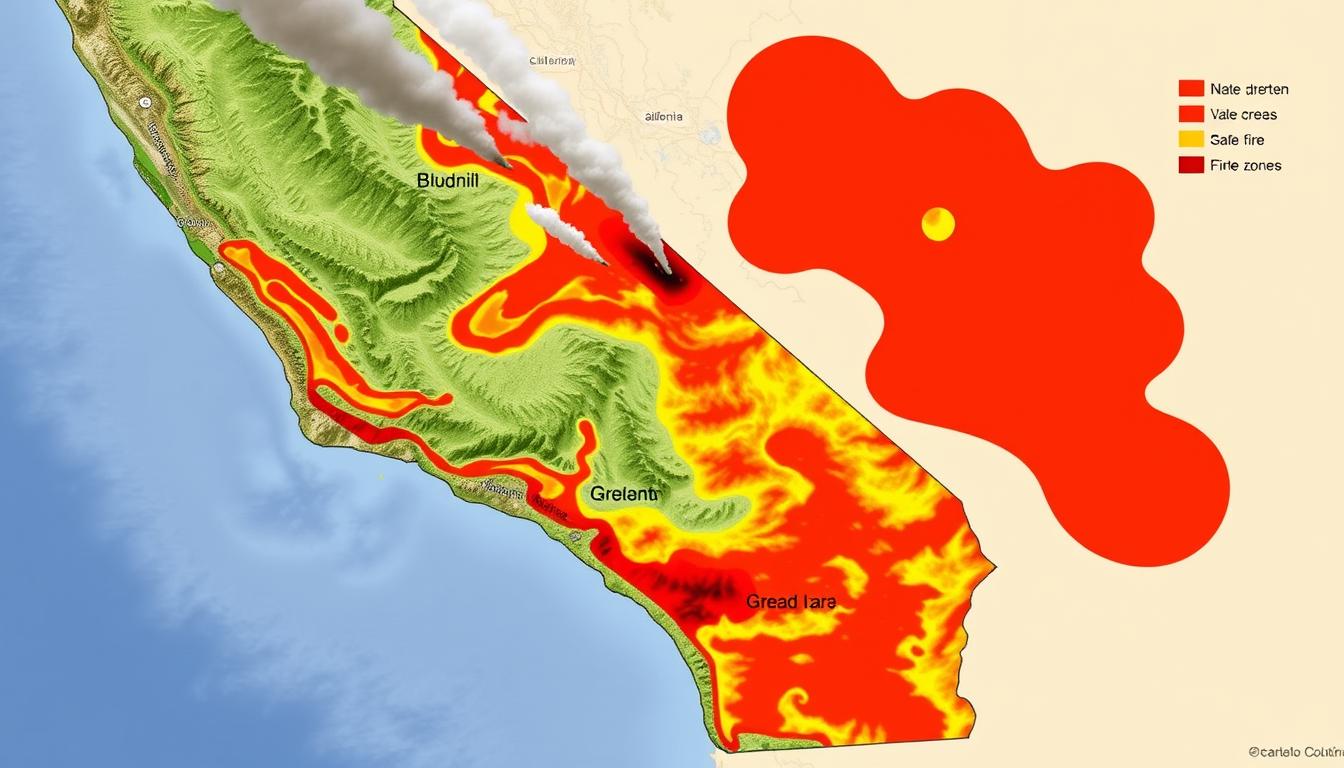The wildfires in California, especially in Southern California, need urgent attention. With fires spreading fast, it’s key for people to use a reliable california fires map. This map shows real-time fire data, helping people know about threats, evacuation orders, and the situation.
Many fires, like the Palisades and Eaton fires, have burned thousands of acres. This has put lives and homes at risk. With almost 200,000 people ordered to evacuate and at least five deaths, staying updated is critical. This article will help you use a wildfire tracker to stay safe.
With the latest fire information, residents can take steps to stay safe. Knowing how to use the fires map, finding evacuation routes, and knowing when to leave can save lives.
Key Takeaways
- The California fires map provides essential real-time updates for residents.
- Evacuations orders have affected close to 200,000 individuals thus far.
- Understanding the impact of active fires is vital for safety and preparedness.
- Staying informed through mobile apps and local news outlets enhances response time.
- Effective emergency planning can save lives and property.
Understanding the California Fires Map
The california fires map is a key tool for those tracking wildfires in California. It shows where fires are and how they’re being controlled. It’s vital for staying safe during wildfire seasons.
What Is a Fires Map?
A fires map is a detailed visual of active wildfires in California. It shows where fires are, how big they are, and their status. Updates from CAL FIRE and local agencies keep the information current and accurate.
Importance of Real-Time Updates
Real-time updates on the map are crucial for public safety. They help people decide when to evacuate or take other safety steps. Knowing the latest about fires helps everyone react quickly to dangers.
How to Read the Map Effectively
To use the california fires map well, you need to know its colors and symbols. Each color means something different, like fire severity or evacuation zones. Knowing these helps people quickly understand risks and what to do.
Current Fire Incidents in California
California’s wildfire season has been tough, making it crucial for everyone to stay alert. Keeping an eye on the current fire incidents map is key. It helps people understand the major fires and stay safe during this hard time.
Major Fires to Watch
The Eaton Fire has spread over 10,600 acres and sadly, five people have lost their lives. The Palisades Fire is the worst in Los Angeles history, burning over 17,000 acres. Wind gusts have reached 60 mph, making it tough for firefighters and alarming for everyone else.
With over 100,000 people under evacuation orders, staying updated on wildfires is vital.
Latest Evacuation Orders
Recent wildfires have led to many evacuation orders. About 100,000 people must be ready to leave quickly. The fire incidents map shows which areas are at risk, helping people act fast.
Staying informed helps keep everyone safe and reduces risks during these unpredictable times.
Fire Containment Statistics
Knowing about fire containment is important for residents. This year, there have been 7,127 wildfires, burning 324,917 acres. The fight against wildfires is ongoing, and keeping up with containment levels is crucial.
Updates from the wildfire containment map show how well firefighters are doing. They also give communities peace of mind about their safety.
How to Access the California Fires Map
Keeping up with wildfires is key for safety. The california fires map gives real-time updates. People can use it to track fires, find affected areas, and get evacuation news.
Official Government Resources
The CAL FIRE website is the main place for the california fires map. It has the latest fire data, including reports and containment updates. Users can find the wildfire tracker for their area and stay updated on fire dangers.
Mobile Apps for Updates
Apps like the Frontline Wildfire Defense App offer real-time fire data. They let users set up alerts based on their home. This way, people get quick updates on local fires, helping them stay safe.
Local News Outlets and Their Importance
Local news is crucial for fire updates. They share important info on evacuations, fire risks, and safety steps. By following local news, people can stay ready and informed during wildfires.
Preparing for Wildfires
Wildfires are a big threat, especially in hot months when fires in California get worse. Being ready can make a big difference. Knowing how to make an emergency plan, what to pack, and the importance of insurance is key.
Creating an Emergency Plan
It’s vital to have an emergency plan. Find safe ways to leave and pick meeting spots for your family. Practice this plan often so everyone knows what to do in an emergency. Keep an eye on the wildfire map California for your area to know the risks and how to act.
During peak fire times, staying updated with California wildfire updates helps. It makes evacuations smoother when needed.
What to Pack for Evacuation
Having the right stuff is important when you have to leave quickly. Make sure your “go-bag” has:
- Vital documents (identification, insurance papers)
- Medications and medical supplies
- Clothing for different weather
- Non-perishable food and bottled water
- Stuff for pets, like food, leashes, and carriers
Being ready with these items makes evacuating easier, especially when fires in California get worse.
Importance of Insurance Coverage
Insurance is key to protect your home from wildfires. If regular insurance is hard to get, consider the California FAIR Plan. A good insurance policy helps cover losses from fires. Being prepared is more important than ever, with more fires and damage in recent years.
How to Stay Informed
It’s vital to stay informed during wildfires to keep safe. Fast changes mean you need reliable info. Use social media, local contacts, and community groups for updates.
Social Media for Real-Time Alerts
Twitter is key for quick wildfire news. Firefighters and agencies post updates fast. Follow verified accounts for the latest on evacuations and fire control.
Local Emergency Services Contacts
Have local emergency numbers ready. This includes fire, police, and medical. It’s crucial for quick help or info when needed.
Community Resources to Help
Community groups offer vital help during wildfires. They provide shelters, food, and evacuation info. Join local meetings to help your community and know where to get help.
| Resource Type | Examples | Access Method |
|---|---|---|
| Social Media | Twitter accounts of fire departments | Follow for updates |
| Emergency Services Contacts | Local fire departments, hospitals | Maintain a contact list |
| Community Organizations | Red Cross, local shelters | Visit or call for assistance |
The Impact of Wildfires
Wildfires are a big threat to the environment and communities in California. It’s important to understand how they affect air quality, wildlife, and the economy.
Air Quality Concerns
Smoke from wildfires makes the air very bad. It spreads harmful pollutants everywhere. People should check the EPA’s Air Quality Index for updates.
Poor air quality can make health problems worse. This is especially true for people who are already sick. So, it’s crucial to take precautions and stay informed.
Wildlife and Habitat Disruption
Wildfires harm local ecosystems by destroying habitats and threatening wildlife. It’s vital to restore these areas after a fire to help species recover. Places like the Sierra Nevada face big challenges due to fires.
These challenges have long-term effects on the environment. They require a lot of effort to fix. It’s important to work on recovery efforts.
Economic Consequences
Wildfires cost a lot of money. They strain state budgets for firefighting and cause property damage. The latest fires could cost over $20 billion in insured losses.
Total losses might reach $50 billion. This is a huge burden on resources. It shows how important it is for communities to prepare for fires.
| Impact Category | Details |
|---|---|
| Air Quality | Smoke pollution affecting health, monitored via EPA’s Index |
| Wildlife Disruption | Destruction of habitats and food sources for local species |
| Economic Impact | Estimated insured losses exceeding $20 billion; total losses up to $50 billion |
Firefighting Efforts and Resources
Fighting wildfires in California is a team effort. Many groups and volunteers work together. It’s important to know who they are and what they do.
Who Fights the Fires?
Firefighters come from many places:
- CAL FIRE
- Local fire departments
- Volunteer fire squads
This mix of teams works well together. They can quickly respond to fires.
Support from Federal Agencies
Federal agencies, like FEMA, help a lot during big fires. They provide:
- Financial help
- More people to help fight fires
This support helps manage fires better. It keeps us updated on wildfire news.
Community Involvement in Firefighting
People not in the fire department also help. They do things like:
- Telling authorities about fires
- Helping in volunteer fire programs
- Working in fire prevention groups
This help makes communities stronger. It also raises awareness about fires.
| Fire Incident | Size (Acres) | Status | Evacuations |
|---|---|---|---|
| Palisades Fire | 17,200 | Active | Ongoing |
| Eaton Fire | 10,600 | Active | Confirmed |
| Hurst Fire | 855 | 10% Contained | Limited |
| Lidia Fire | 350 | 40% Contained | None |
Technology in Fire Management
In recent years, technology has become a key ally in managing wildfires in California. The need for new solutions is growing as fires become more frequent and intense. Tools like drones, predictive modeling, and virtual reality training are changing firefighting. They help make responses more efficient and effective.
Drones and Surveillance
Drones are now crucial in wildfire management. They give aerial views of fires, helping teams assess damage and monitor fires remotely. Drones can reach dangerous areas, making them essential for real-time data. Their use has doubled, showing their value in tracking wildfires.
Predictive Modeling and AI
Predictive modeling and AI are key in understanding fire behavior. Advanced algorithms predict how fires will spread, helping with resource planning. AI technology gives a detailed analysis of fires, guiding firefighting strategies. This is vital for preparing for fires and keeping communities safe.
Virtual Reality Training for Firefighters
Firefighter training has been transformed by virtual reality. VR offers immersive training in safe, high-stress environments. This prepares firefighters for real situations, improving their response. It ensures teams are ready to fight wildfires effectively.
| Technology Type | Application | Benefits |
|---|---|---|
| Drones | Aerial surveillance, damage assessment | Access hard-to-reach areas, real-time data collection |
| Predictive Modeling | Fire behavior prediction, resource allocation | Enhanced decision-making, strategic planning |
| Virtual Reality | Firefighter training | Safe, realistic training experiences |
Post-Fire Recovery Process
The recovery after a wildfire is both important and complex, especially in California. It involves three main phases. Each phase focuses on different tasks to ensure safety and restoration.
Assessing Damage to Property
First, teams assess damage to properties. They figure out what’s lost and what can be saved. Specialized teams check for structural damage and the environment’s condition.
These assessments are key for planning future recovery efforts. Recent updates show more severe damage in wildfires.
Debris Removal and Cleanup
After assessing, debris removal starts. Local governments lead the cleanup in burn areas. This is crucial for those wanting to rebuild.
Fire debris can cause hazards like soil erosion or water contamination. Quick action is needed to avoid these risks.
Resources for Affected Families
Families hit by wildfires need support. This includes temporary housing, financial help, and counseling. Programs for rebuilding homes offer valuable guidance.
Studies show communities with strong support systems recover better from wildfires in California.
Climate Change and Wildfires
Climate change is making wildfires in California worse. Rising temperatures and droughts lead to more and bigger fires. The state’s 20 largest fires have happened in the last five years, showing we need to act fast.
The Link Between Climate and Fire Frequency
Hotter temperatures and longer droughts make wildfires more likely. The August Complex and Dixie fires, which burned over a million acres, show the danger. California’s wildfire map shows where fires are most likely, making it clear we need to act quickly.
Long-Term Solutions for Prevention
We need many ways to fight wildfires. Better land management, controlled burns, and firebreaks can help a lot. Working together, we can reduce the damage from fires and stay safe.
Community Initiatives to Combat Climate Change
Local groups and communities are fighting climate change. They plant trees, restore habitats, and push for policy changes. These efforts help prevent wildfires and bring people together.
How to Help Affected Communities
The wildfires in California have hurt many communities. Your help can make a big difference. You can donate money, volunteer, or support local businesses. Every bit helps in the wake of these fires.
Donation Opportunities
Many groups are working to help families hit by the wildfires. You can donate to:
- The American Red Cross, which offers shelter, food, and emotional support. Donate online, call 1-800-RED CROSS, or text “REDCROSS” to 90999 for $10.
- The California Community Foundation, with a Wildfire Recovery Fund for long-term help.
- World Central Kitchen, delivering meals to first responders and families.
- The Los Angeles Regional Food Bank, accepting food donations daily from 8 a.m. to 5 p.m.
Volunteering for Local Organizations
Volunteering can help with recovery efforts. Local groups need help with tasks like:
- Emergency Network Los Angeles, helping those affected by disasters.
- UCLA, offering shelter and health services.
- The Salvation Army, providing food, water, and shelter for victims.
Supporting Local Businesses
Helping local businesses is key to economic recovery. You can:
- Share local businesses online to boost visibility.
- Shop at businesses affected by the fires.
- Join community fundraisers like those on GoFundMe for wildfire relief.
| Organization | Assistance Provided | Donation Method |
|---|---|---|
| American Red Cross | Shelter, food, emotional support | Website, call 1-800-RED CROSS, or text “REDCROSS” to 90999 |
| California Community Foundation | Long-term support | Website donations |
| World Central Kitchen | Meals for first responders and families | Website donations |
| Los Angeles Regional Food Bank | Food assistance | Donate at distribution centers |
Future of Fire Management in California
California is at a higher risk for wildfires, but new fire management methods are coming. New firefighting tech, like real-time fire data and better wildfire trackers, helps respond faster. This tech gives important info to people living in fire-prone areas.
Firefighters now have better tools and tracking systems. This means they can fight fires more efficiently and effectively.
Innovations in Firefighting Technology
Artificial intelligence and robotics are changing firefighting in California. These technologies help detect and fight fires faster. This is crucial as wildfires happen more often.
Real-time fire data is key in these efforts. It shows a future where communities have stronger tools against wildfires.
Policy Changes and Community Strategies
New policies are also important. More money for agencies like CalFire shows a commitment to fighting wildfires. With millions of trees lost, communities must be ready.
Drills, updated emergency plans, and local efforts are crucial. They help prepare for the next fire season.
Preparing for the Next Fire Season
Together, we can make communities less vulnerable to wildfires. The fire season in California is getting longer. This means we need to stay ready all the time.
Knowing about the California fires map is important. It helps people stay informed and ready for wildfires. Working together will make communities stronger against unpredictable wildfires.




